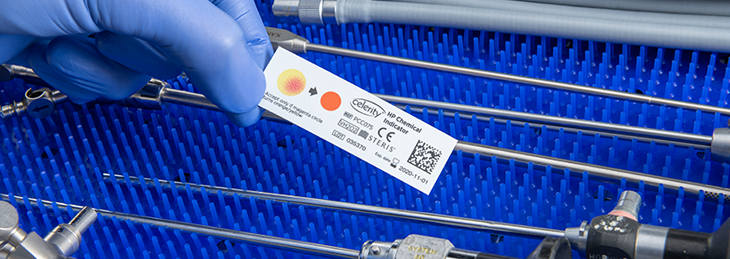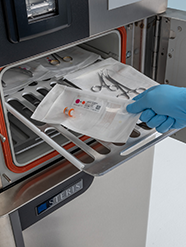Knowledge Center
May 27, 2020
What if One Chemical Indicator Fails?


1 Internal CI Visible, and 1 Internal CI Under
Devices in an area considered least
accessible to sterilant
Everything was done as expected – the devices went through decontamination, completed a successful washer and thermal disinfection cycle, and were inspected, prepared and packaged successfully following all steps outlined in the instrument tracking software.
The sterilization protocol was followed, the cycle was successful, all critical sterilization parameters were met, and the Biological Indicator (BI) was negative. The sterilization load was properly stored and released. Every step was successful. But now, a pack is back in the Sterile Processing Department (SPD) because the Operating Room (OR) found a failed chemical indicator and returned the complete unused set to the SPD. Now What?
Chemical indicators (CIs) are an important part of any quality assurance program. One or more chemical indicators should be placed in each sterilization package, tray, or container that is being processed. ANSI/AMMI ST79 recommends a Type 5 or Type 6 chemical indicator for internal pack monitoring because these types of CIs provide the user with most information about all critical steam sterilization parameters.
But what if only one Chemical Indicator fails?
It's important to understand that we're talking about internal chemical indicators. A failed CI such as a Bowie-Dick test, should be treated differently, as these failures identify a possible equipment malfunction that should be investigated. Download the Bowie-Dick Troubleshooting Guide.
If one internal CI in a sterilization load fails, this identifies a failed set - not an entire load. The purpose of the internal CI is to confirm that steam penetrated the specific set. A failure of a single pack could be due to several reasons including an air pocket, incorrect packaging or the configuration of the tray which prohibited sterilant penetration. Typically, the whole sterilization load is only considered failed if the BI shows a positive result, or in the case of wet packs after steam sterilization.
What Do the Standards Say?
ANSI/AAMI ST79:2017 10.5.2.2 states:
"If a CI is nonresponsive or inconclusive, it is possible that the entire load is not sterile (i.e., the sterilization process failed). It is also possible that errors in loading or packaging have resulted in sterilization failures in some, but not all, packages in the load. Therefore, a single nonresponsive or inconclusive CI should not be considered definitive evidence that the entire load is nonsterile. The supervisor should exercise professional judgment in determining whether to recall the entire load, taking into account all factors having a bearing on the efficacy of the cycle and all performance indicators (physical monitors, CIs, and BIs)."
Where the Failed Chemical Indicator is Found
What to do if a failed chemical indicator is found in the SPD after sterilization
If a failed CI is identified in the SPD, this typically means it is a Type 1 external chemical indicator and the pack was not properly exposed to sterilant. If it was part of a challenge test pack for qualification testing, treat this as a sterilization failure. In both cases, follow your facility's policies and procedures.
What to do if a failed chemical indicator is visible through a peel pack
All peel packs should be inspected prior to release to make sure all internal chemical indicators have all turned. Since these packs should have never made it to the OR they would have been discovered in the SPD. The pack should be opened, and the device should be reprocessed.
What to do if a failed chemical indicator is found in the Operating Room
Internal failed CIs discovered in the OR should result in the rejection of the set and should be returned to decontamination for full reprocessing. Follow your facility's policies and procedures for sterilization failures.
If only one chemical indicator has failed and an equipment malfunction, such as an autoclave malfunction, is not suspected, then loading technique should be reviewed as a possible cause of the failure.

Loading technique is a common cause for sterilization failures. Ensure placement in the chamber is appropriate, and not to overload the sterilizer.
Review the process:
- Were there too many instruments in the set?
- Was the placement in the sterilization chamber not appropriate?
- Was the chamber overloaded?
- Divider trays for multiple peel pouches are recommended with paper (or Tyvek) being placed against plastic side of other pouches in dividers. Was this done properly?
- Was the CI placed under instruments?
- Was the CI expired?
Generally, when one failed CI is discovered, loading technique should be the first thing reviewed and the set or package should be opened and reprocessed. Facility policy and procedures should be used to determine whether to recall the entire load, and all performance indicators such as physical monitors, other CIs in the load, and biological indicator results should be reviewed.
Knowledge Center Category List
| FOLLOW US | |
|---|---|
|
|
|
|
|
|
|
|
|
|
|
|


